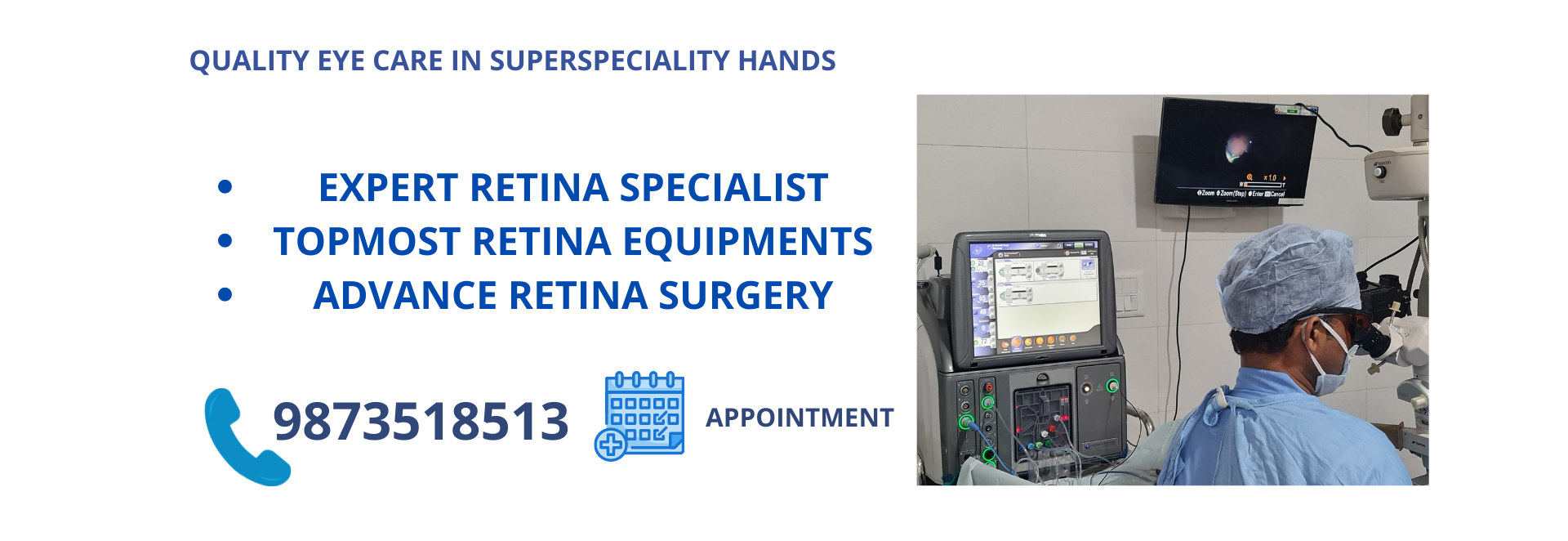
Vedanta Netralya clinics
We aim to care for our patients compassionately in a technologically cutting edge environment using the latest advances in clinical research.
The Retina
The retina is the innermost layer of the wall of the eye and is made up of light sensitive cells known as rods and cones, which detect shape, colour and pattern. It is supported on the inside by the jelly-like vitreous, which fills the eyeball behind the lens.
On its outer side the retina is attached to the choroid, or middle layer, which is rich in blood vessels. Nerve fibres leaving the retina bundle together to form the optic nerve, which relays visual information to the brain.
What is retinal detachment?
Retinal detachment is when the retina pulls away from the tissue around it (the choroid), which supplies it with oxygen and nutrients.
When the retina is detached it can no longer function and vision is lost.
Causes of retinal detachment
The most common cause of retinal detachment is age-related shrinkage of the vitreous gel, which may lead to tearing at a weak point in the retina. Once such a tear or hole develops, fluid can collect beneath it and reduce the adhesion of the retina to the choroid, resulting in a detachment. Injury to the eye can also cause retinal detachment, although this is less common.
Who is at risk of retinal detachment?
People at increased risk of retinal detachment include:
- Near-sighted people.
- People who have undergone cataract surgery.
- People who have undergone cataract surgery.
Symptoms of retinal detachment
Retinal detachment is painless. A retinal tear may be accompanied by the sensation of flashing lights in the affected eye or showers of dark floaters and blurred vision.
As the retina detaches it often causes a dark shadow, like a curtain or veil, in the peripheral vision, which usually progresses to complete vision loss.
See your doctor or eye specialist straightaway if you experience any of the above visual disturbances, because a retinal detachment needs prompt corrective surgery to prevent permanent damage to your eyesight.

Surgery for retinal detachment
Retinal detachment surgery involves reattaching the retina to the back of the eye and sealing any breaks or holes. Your retinal specialist will examine your eye to decide the most appropriate operation.
Operative procedures for retinal detachment
There are various methods available to reattach the retina, including:
- Pneumatic retinopexy – this is the simplest procedure for repair of a detachment, but is not suitable for all cases. The retinal surgeon injects a gas bubble into the vitreous cavity and treats the tear(s) with either laser or cryotherapy (freezing). The bubble presses the retina flat against the wall of the eye and the laser or freezing sticks the retina down. In order for the retina to remain in place after surgery it is important to follow the surgeon’s instructions on post-operative head positioning.
- The gas gradually disappears over the days or weeks following the surgery. Scleral buckling – the retinal tear is treated with cryotherapy, the fluid under the retina drained and a specially-shaped piece of silicone rubber sutured to the sclera, or outer wall of the eye. The silicone creates an indent, which pushes the eye-wall back onto the retina. The scleral buckle remains in place indefinitely unless complications arise.
- Vitrectomy surgery – under an operating microscope the vitreous is surgically removed using very fine instruments, any tears are treated with laser or cryotherapy and the eye is filled with gas or silicone oil. Once again it is important to follow instructions regarding post-operative head positioning in order to allow the retina to stick down. People who have had vitrectomy surgery will experience temporary poor vision while the eye is filled with gas, but if the surgery is successful the vision will improve as the gas reabsorbs and is replaced with the eye’s own clear fluid. If silicone oil is used it does not dissolve by itself, and further surgery is usually necessary after a few months.
After surgery for retinal detachment
Immediately after the operation, you can expect:
- The eye will be covered with an eye pad and perhaps a protective eye shield.
- You may need to stay in hospital overnight or, occasionally, longer.
During the post-operative period:
- Your eye may be uncomfortable for several weeks, particularly if a scleral buckle has been used.
- Your vision will be blurry – it may take some weeks or even three to six months for your vision to improve.
- Your eye may water.
- Expect a ‘gritty’ feeling on the surface of your eye if stitches have been used.
- Avoid rubbing or pressing on the eye.
- You may need to wear an eye pad for protection at night while your eye is healing.
- Make sure to follow all directions for medications, such as eye drops.
- Avoid vigorous activity for some weeks following surgery.
- Obey all instructions on head positioning.
- See your surgeon immediately if you experience severe pain.
If you have had gas inserted into your eye as part of your retinal re-attachment procedure, it is extremely important that you do not fly until it has completely reabsorbed. This may take up to four weeks
Possible complications of surgery for retinal detachment
Risks and complications depend on the procedure used, but can include:
- Cataract formation (loss of clarity of the lens of the eye).
- Glaucoma (raised pressure in the eye).
- Infection.
- Haemorrhage (bleeding) into the vitreous cavity.
- Vision loss.
- Loss of the eye, although with modern surgical techniques this is a very unlikely outcome.
Long term outlook for retinal detachment
In most specialist centres around nine out of ten retinal detachments are successfully repaired with a single operation. In the remaining cases, the retina re-detaches and needs another operation. The final success rate is over 95 per cent.
Recovery of vision may take 8-12 months . In very less cases, surgery gets failed and chances of pthisis bulbi after many surgery remains.
Whether or not your vision returns depends not only on the success or failure of the operation, but also on the duration, extent and location of the detachment. For example, if the macula (the part of the retina responsible for central vision) has detached, it is unlikely that full vision will ever return, even if the operation is successful.
Are there other forms of treatment for retinal detachment?
Retinal detachment can only be repaired with surgery. If left untreated, your vision will most likely worsen beyond repair. Seeing an eye specialist as soon as you experience symptoms leads to the best outcome.
RETINA DETCAHMENT SURGERY REVIEWS
Our Patients valuable reviews for us. See what they said about our Eye Hospital.











